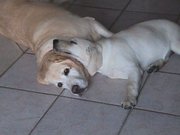 In a household pack of domestic Dogs, the animals may sleep, eat, play, run, and
attack according to pack rules.
In a household pack of domestic Dogs, the animals may sleep, eat, play, run, and
attack according to pack rules.|
Dog breeds, Pack |
A pack of canines?most notably wolves, the domestic Dog, and some other wild canines?is a group of animals that is organised according to a strict social hierarchy. In the wild, the pack is led by an alpha male and an alpha female. This social structure was originally thought to allow the wolf, a social predator, to take prey many times its size; new theories are emerging, however, that suggest the pack strategy instead maximizes reproductive success and has less to do with hunting.
The size of the pack may change over time and is controlled by factors including habitat type, individual personalities, and food supply. Generally packs contain between two and six animals, although packs with more than 20 have been recorded. The hierarchy or rank order of the pack is relatively strict, with the alphas (one male, one female) on top and the omega at the bottom. The hierarchy affects all activity in the pack, from which wolf eats first to which is allowed to breed (generally only the alpha pair).
 In a household pack of domestic Dogs, the animals may sleep, eat, play, run, and
attack according to pack rules.
In a household pack of domestic Dogs, the animals may sleep, eat, play, run, and
attack according to pack rules.
With the domestic Dog, households having more than one resident Dog quickly establish their own hierarchy along similar lines, and the Dogs may roam and run as a small pack.
The alpha pair have the most social freedom of all the animals in a pack, but they are not "leaders" in the sense humans usually think of the term. They do not give the other wolves orders. The alphas simply have the most freedom to choose where they would like to go and what they would like to do, and the rest of the pack usually follows along.
While most alpha pairs are monogamous with each other, there are exceptions. An alpha animal may preferentially mate with a lower ranking animal, especially if the other alpha is closely related (a brother or sister, for example). Wolves also do not "mate for life". The death of one alpha does not affect the status of the other alpha, who will usually just take another mate.
Usually, only the alpha pair are able to successfully rear a litter of pups. (Other wolves in a pack may breed, and may even produce pups, but usually they lack the freedom or the resources to raise the pups to maturity.) All the wolves in the pack assist in raising wolf pups. Some pups may choose to stay in the original pack to reinforce it and help rear more pups while others disperse.
Rank order is established and maintained through a series of ritualized fights and posturings best described as ritual bluffing. Wolves prefer psychological warfare to actual fighting and high ranking status is based more on personality or attitude than on size or strength. Rank, who holds it, and how it is enforced varies widely between packs and between individual animals. In large packs full of easygoing animals, or in a group of juvenile animals, rank order may shift almost constantly, or even be circular (animal A dominates animal B who dominates animal C who dominates animal A).
Loss of rank can happen gradually or suddenly. An older wolf may simply choose to give way when an ambitious challenger presents itself, and rank will shift without bloodshed. Or the older animal may choose to fight back, with varying degrees of intensity. While an extremely high percentage of wolf aggression is non-damaging and ritualized, a high-stakes fight can result in injury. The loser of such a damaging fight is frequently chased away from the pack, or, rarely, may be killed as other, aggressively aroused wolves attempt to join in. This kind of dominance fight is more common in the winter months, when mating occurs.
New packs are formed when a wolf leaves its birth pack and claims a territory. Wolves searching for other wolves with which to form packs can travel very long distances in search of suitable territories. Dispersing individuals must avoid the territories of other wolves because intruders on "owned" territories are chased away or killed. This probably explains wolf "predation" of Dogs. Most Dogs, except perhaps large, specially-bred attack Dogs, do not have much of a chance against a wolf protecting its territory from the unwanted intrusion.
pack, canines, how dogs establish hierarchy language, wolves, domestic Dog, other wild canines, group of animals, organized, strict social hierarchy, Dogs, breed, breeders, name, training, picture